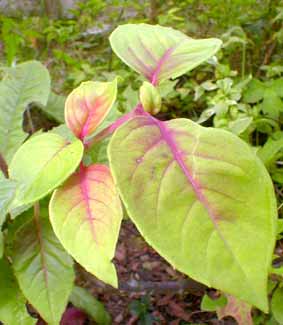
'Autumnale' Fuchsia
Orion's humbled & still mortal feet
Dared not adventure. In the Goddess' face
Imploringly he gaz'd. "Advance!" she said,
In tones more sweet than when some heavenly bird,
Hid in a rosy cloud, its morning hymn
Warbles unseen, wet with delicious dews,
And to earth's flowers, all looking up in prayer,
Tells of the coming bliss. "Believe--advance!"
-Richard Henry Horne
(1802-1884)
(1802-1884)
Fuchsia austromontana 'Autumnale' is something I bought by accident from a nursery that offered it as a hardy perennial fuchsia. In reality it is very iffy for survival through even our moderate winters, as some references say it can die below 35 degrees Fahrenheight. It is more heat-hardy than frost-hardy.
One northwest grower, however, says it does sometimes perennialize in Puget Sound gardens, so we just had to wait to wait & see what would come of it after its first winter with us. it seemed likely to be a defacto annual, & that indeed turned out to be the case. Too bad too, as I would so love to have seen it adapt as a perennial subshrub.
It is frequently grown locally in hanging baskets which can be brought to shelter for winter, but for our tiny start, it was just popped in the ground in a protected location under an azalea & amidst crane's-bills. It spent spring, summer, & autumn creeping about on the ground, apparently looking for better light.
The flowers have scarlet sepals, & the corolla is purple-red. However, ours did not bloom during its seasons with us. But with such glamorous foliage, whether it produced small & few flowers or none at all was unimportant. Blooms play second-fiddle to the foliage's performance.
The young leaves of this half-hardy fuchsia start out green & coppery orange, aging to an increasingly vibrant dark red, coral pink, & gold, more reminiscent of coleus than fuchsia leaves. The leaves seemed to be a different color every month. The photo on this page shows some leaves in October when they were less colorful than in summer but still rather showy.
Growth is almost entirely prostrate unless grown in a basket or ledge it can spill over. It sprawls in all directions, & will occasionally climb up into the nearby azalea. The stems get quite woody by Fall. It tries to keep growing even in winter, but by the time early spring roles around, it's done for. To have it perpetually in a Northwest garden seems likely to require nurturing fresh starts indoors from autumn cuttings, restored to the garden when the last threat of frost has passed.
The species is native to the cloud forests of Peru & Bolivia. Its species name mean "southern mountains," alluding to the Peruvian Andes where it was first collected.